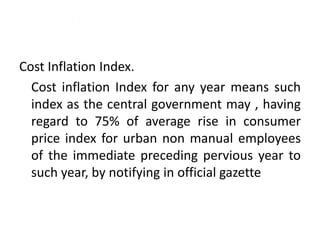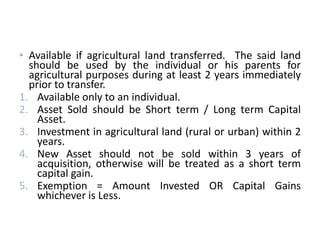Lecture 14 income from capital gains.ppt
- 1. Income From Capital Gains Lecture 14
- 2. • CAPITAL GAINS “Any profit or gains arising from the transfer of capital assets is taxable under the head capital gains in the previous year in which the transfer has taken place.”
- 3. Conditions for Gains to be charged There should be a capital asset. under Capital Gains • The capital asset should be transferred by the assessee. • Such transfer should take place during the previous year. • The profits or gains should arise as a result of this transfer. • Such profit or gain should not be exempted from tax under sections 54, 54B, 54D, 54EC, 54F and 54G & 54GA.
- 4. DEFINITION OF CAPITAL ASSETS • Capital asset is defined to include property of any kind, whether fixed or circulating, movable or immovable, tangible or intangible
- 5. What is not a Capital Asset? a) Any stock-in-trade, consumable stores or raw material held for the purposes of business or profession. b) Movable property of the Assessee including wearing apparel and furniture held for his personal use or for the use of any member of his family dependent on him. The exception to this condition is jewellery, which is treated as a capital asset, even though it is meant for personal use.
- 6. c) Agricultural land in India provided it is not situated in urban area. d) 6 ½ % Gold Bonds, 7% Gold Bonds or National Defence Gold Bonds, issued by the central government. e) Special Bearer Bonds, and f) Gold Deposit bonds issued under Gold Deposit Scheme of 1999.
- 7. Type of Capital Assets • Short Term Capital Asset “Short term capital assets” means a capital asset held by the assessee for not more than 36 months, immediately prior to its date of transfer. However, the following assets are treated as short term assets if they are held for not more than 12 months, they are: 1. Equity or preference shares in a company 2. Securities like debentures, government securities listed in a recognized stock exchange in India. 3. Units of UTI and 4. Units of mutual funds. 5. An asset other than a short-term capital asset is regarded as a “long term capital asset”.
- 8. • Long Term Capital Asset – An asset, which is held by an assessee for 36 months or more, immediately before its transfer, is called Long Term Capital Assets. In other words, an asset, which is transferred on or after 36 months of its acquisition by assessee, is called Long Term Capital Assets.
- 9. Transfer • Transfer, in relation to a capital asset, includes sale, exchange or relinquishment of the asset or extinguishments of any right therein or the compulsory acquisition thereof under any law. • In simple words Transfer includes: • Sale of asset • Exchange of asset • Relinquishment of asset (means surrender of asset) • Extinguishments of any right on asset (means reducing any right on asset) • Compulsory acquisition of asset.
- 10. FULL VALUE OF CONSIDERATION • Full value means whole price without any deduction and consideration in which transferor receives in lieu of asset he parts with.
- 11. EXPENDITURE ON TRANSFER • Expenditure incurred wholly and exclusively in connection with transfer of capital asset is deductible from full value of consideration. This means expenditure incurred which is necessary to effect the transfer like brokerage commission, cost of stamp, registration fees and all
- 12. COST OF ACQUISITION • Cost of acquisition of an asset is the value for which it is acquired by the Assessee, expenses of capital nature for acquiring the title are include in cost of acquisition
- 13. COST OF IMPROVEMENT It means all expenses of capital nature incurred in making any addition/ alteration to capital asset by assessee. 1) Expenditure after 31 mar 1981
- 14. INDEXED COST OF ACQUISITION OR IMPROVEMENT Cost Inflation Index. Cost inflation Index for any year means such index as the central government may , having regard to 75% of average rise in consumer price index for urban non manual employees of the immediate preceding pervious year to such year, by notifying in official gazette
- 15. COMPUTATION OF INDEXED COST. 1) Capital asset acquired before 1-4-1981 Cost X Cost Inflation Index in the year of Transfer Or FMV on 01.04.1981 Cost Inflation Index for yr 1981-82 (whichever is high) 2) Capital asset acquired after 1-4-1981 Cost X Cost Inflation Index in the year of Transfer Cost Inflation Index for yr of purchase
- 16. 3) Capital asset acquired by assesse before 1-4-1981 & originally acquired by previous owner before 1-4-1981. Cost to Previous Owner X Cost Inflation Index in the year of Transfer Or FMV on 01.04.1981 Cost Inflation Index for yr 1981-82 (whichever is high) 4) Capital asset acquired by assesse after 1-4-1981 & originally acquired by previous owner before 1-4-1981. Cost to Previous Owner X Cost Inflation Index in the year of Transfer Or FMV on 01.04.1981 CI Index for yr the asset is first held by (whichever is high) assesee 5) Capital asset acquired by assesse after 1-4-1981 & originally acquired by previous owner after 1-4-1981. Cost to Previous Owner X Cost Inflation Index in the year of Transfer CI Index for yr the asset is first held by assesee
- 17. Indexed Cost of Improvement • 1. Ignore Improvement Before 1.04.1981 • Indexed Cost = Cost of Improvement X CI Index in Yr of Transfer CI Index in Yr of Improvement
- 18. SLUMP SALE • Slump sale means transfer of one or more undertakings as a result of sale for lump sum consideration without values being assigned to individual assets and liabilities in such sales
- 19. EXEMPTION U/S 54 • Conditions : 1. Gains are from Transfer of Residential House Property 2. Applicable only to Individual / HUF 3. Asset Sold is a Long Term Capital Asset 4. Assessee should invest in another Residential House Property within the specified time limit. 5. New asset should not be sold within 3 years of acquisition, otherwise will be treated as a short term capital gain. 6. Exemption = Amount Invested OR Capital Gains whichever is Less.
- 20. EXEMPTION U/S 54B • Available if agricultural land transferred. The said land should be used by the individual or his parents for agricultural purposes during at least 2 years immediately prior to transfer. 1. Available only to an individual. 2. Asset Sold should be Short term / Long term Capital Asset. 3. Investment in agricultural land (rural or urban) within 2 years. 4. New Asset should not be sold within 3 years of acquisition, otherwise will be treated as a short term capital gain. 5. Exemption = Amount Invested OR Capital Gains whichever is Less.
- 21. EXEMPTION U/S 54D • Available if land or building forming part of an industrial undertaking is compulsorily acquired by the govt and which is used during 2 years for industrial purposes prior to acquisition. 1. Available to any person. 2. Asset Sold should be Short term / Long term Capital Asset. 3. Investment in land or building for industrial purposes within 3 years. 4. New Asset should not be sold within 3 years of acquisition, otherwise will be treated as a short term capital gain. 5. Exemption = Amount Invested OR Capital Gains whichever is Less.
- 22. EXEMPTION U/S 54EC • Available if any long term capital asset is transferred after 31.3.2000. 1. Available to any person. 2. The asset should be a Long term capital asset. 3. Investment within 6 months in bonds of NHAI or RECL which are redeemable after 3 years. 4. New Asset should not be sold within 3 years of acquisition, otherwise will be treated as a short term capital gain. 5. Exemption = Amount Invested OR Capital Gains whichever is Less.
- 23. EXEMPTION U/S 54F 1. Available if any long term capital asset( other than a residential house property) is transferred, Available to an individual / HUF. 2. Investment should be made in a residential house property within time Limit . 3. New Asset should not be sold within 3 years of acquisition, otherwise will be treated as a short term capital gain. 4. Exemption = Amount Invested * Capital gains Net sale consideration
- 24. EXEMPTION U/S 54G • Available if any land, building, plant or machinery is transferred in order to shift an industrial undertaking from urban to rural area. 1. Available to any person. 2. Asset may be short term / long term. 3. Investment should be made in land, building or plant and machinery to shift the undertaking in a rural area. 4. New Asset should not be sold within 3 years of acquisition, 5. Exemption = Amount Invested OR Capital Gains whichever is Less
- 25. EXEMPTION U/S 54GA • Available if any land, building, plant or machinery is transferred in order to shift an industrial undertaking from any area to SEZ. 1. Available to any person. 2. Asset may be short term / long term. 3. Investment should be made in land, building or plant and machinery to shift the undertaking to SEZ area. 4. New Asset should not be sold within 3 years of acquisition, 5. Exemption = Amount Invested OR Capital Gains whichever is Less
- 26. CAPITAL GAIN ON DEPRECIABLE ASSESTS • In Income Tax Act depreciation is provided on only four types of assets: 1. Buildings 2. Furniture 3. Machinery and plant 4. Intangible Assets • For calculating depreciation different blocks are made based on the name of asset and then the rate of depreciation, thus a block will contain only that asset which will have the same name and same depreciation. • Depreciation = (WDV of the block as on 1st April of PY + Addition to the block – Selling price of the assets sold) * Depreciation rate. • If an asset is used for less than 180 days during a P.Y. then only ½ of the depreciation will be provided on that asset.
- 27. THANK YOU


























